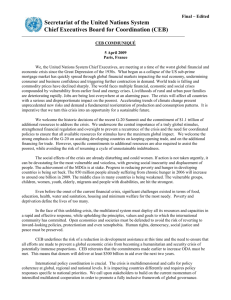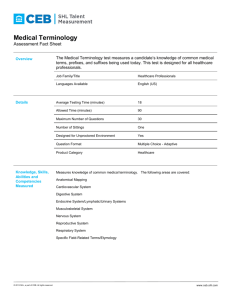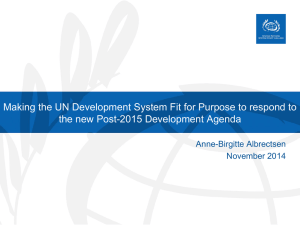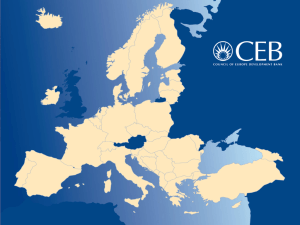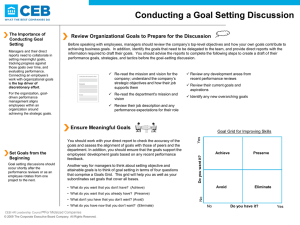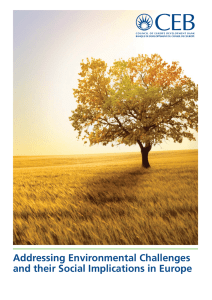CEB
advertisement
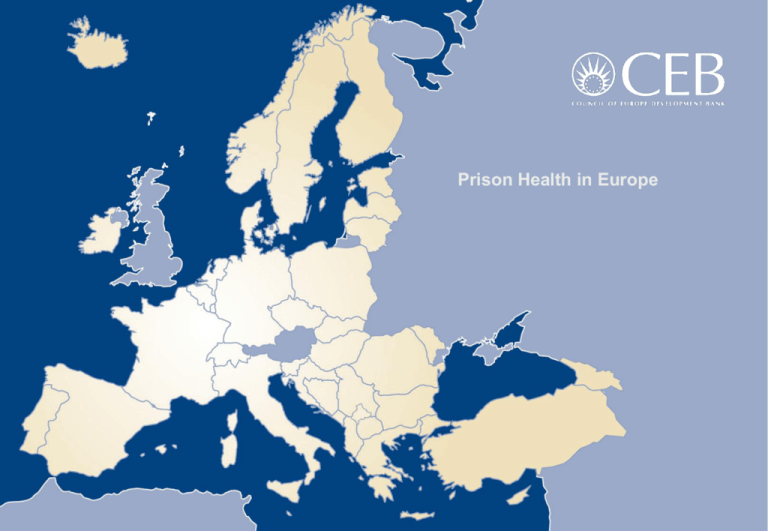
Prison Health in Europe A multilateral development bank with a social vocation The oldest European supranational financial institution set up in 1956 by 8 member countries of the Council of Europe 41 Member States 22* Central, Eastern and South Eastern European countries, forming the Bank’s target countries, are listed among the Member States * Including Kosovo as of 4 November 2013 Key figures € 37 billion in projects financed since inception Loans outstanding: € 12.5 billion Total assets: € 24.5 billion Own funds: € 7.3 billion Loans disbursed in 2013: € 1 845 million Aaa/AA+ credit rating (Moody’s: Aaa negative outlook, Standard & Poor's: AA+ stable outlook and Fitch Ratings: AA+ stable outlook) (figures at Dec. 2013) Loans outstanding 13,500 12,000 11,483 11,965 12,007 12,423 12,198 11,988 12,075 12,131 2006 2008 2010 10,765 10,500 9,903 in million euros 9,350 8,442 8,630 9,000 7,743 7,500 6,337 6,000 6,076 6,402 5,629 5,842 4,500 3,000 1,500 0 1994 1996 1998 2000 2002 2004 2012 12,582 4 sectoral lines of action Strengthening social integration Managing the environment Supporting public infrastructure with a social vocation Micro, small and medium sized enterprises (MSMEs) 4 sectoral lines of action Strengthening social integration Aid to refugees, migrants and displaced persons Housing for low-income persons Improvement of living conditions in urban and rural areas Managing the environment Natural or ecological disasters Protection of the environment Protection and rehabilitation of historic and cultural heritage 4 sectoral lines of action Supporting public infrastructure with a social vocation Health Education and vocational training Infrastructure of administrative and judicial public services Micro, small and medium-sized enterprises (MSMEs) Creation and preservation of viable jobs Infrastructure of administrative and judicial public services The CEB added this sectoral line in 2006, following the 3rd Summit of Heads of States in Warsaw, “to facilitate, through its own means of action, the implementation of policies which aim at the consolidation of democracy, the promotion of the rule of law and respect for human rights, notably … in the organisation, operation and infrastructure of administrative and judicial public services...“ Prison infrastructures must respect the European Prison Rules (January 2006). Examples of project: Moldova In 2013, a € 39 million project was approved to part-finance the construction of a new penitentiary in Moldova. The new project will allow closing the existing penitentiary facility. The new penitentiary will have up-graded facilities (sanitation facilities, education and training areas, recreational and physical exercise facilities, visiting areas… Examples of project: Croatia In 2010 and 2011, two projects were approved to part-finance the rehabilitation/construction of two penitentiaries in Croatia. € 50 million to construct the Sibenik penitentiary, also providing for drug treatment regime, and including dedicated areas for recreational and leisure activities, sport facilities and healthcare unit. € 6.48 for the rehabilitation and extension of the Zagreb prison, including a centre for psychosociological diagnosis. The prison will also include areas for recreational and leisure activities. Examples of project: France In 2014, a € 39.8 million project was approved to part-finance the construction of two new prisons in France. The new prisons will alleviate prison overcrowding, be conducive to community life and provide a better environment for prisoners’ reintegration, with workshops, training areas, libraries and sport facilities. Examples of project: Ireland In 2013, a € 41million project was approved to partfinance the construction of the Cork prison and the new National Children Detention Facility. Both of them foresee a full range of infrastructure services including workshops, education and training areas, recreational facilities and medical facilities. Dental care units are foreseen for the National Children Detention Facility. Loan terms Rate : fixed or variable, based on CEB’s cost of funds (AAA)+modest margin Length : up to 15 years with a possible grace period Amount : up to 50%* of total project cost Currency : according to borrower’s needs and CEB’s funds available Guarantee: Member State, local authority, first class financial institution * Up to 90% in the CEB's target countries Borrowers Member States Local or regional authorities Financial institutions Financial means of action 1. Loans loans to Member States of the CEB loans guaranteed by a CEB Member State granted to any legal person approved by that member loans granted to any legal person approved by a CEB Member State covered by adequate guarantees Financial means of action 2. Guarantees Upon conditions to be fixed by the Administrative Council in each case, the CEB may grant guarantees to financial institutions approved by a member for loans to further the realisation of the purposes set out in Article II of the CEB's Articles of Agreement Financial means of action 3. Trust Accounts According to the provisions for operating the Social Dividend Account or those governing other trust accounts, the CEB may award grants – under the form of interest-rate subsidies, technical assistance grants, loan guarantees or donations – for the purpose of financing investment projects or technical assistance activities Project cycle Completion Evaluation Disbursements & monitoring Negotiation of loan agreement Approval by the AC Appraisal Identification Project cycle Presentation of the project by the Ministry of Foreign Affairs, together with a letter of intent The borrower may be assisted by CEB staff in the presentation Appraisal: Opinion on social and political admissibility (Secretary General in Strasbourg) Technical and financial appraisal (CEB) Global and final recommendation (CEB) Project cycle Approval by the Administrative Council Disbursements and monitoring In accordance with the contracts and the work progress Completion report Required at the end of the project Evaluation Impact and sustainability of the project in order to assess performance and quality as well as to draw lessons for future project preparation Thank you for your attention
